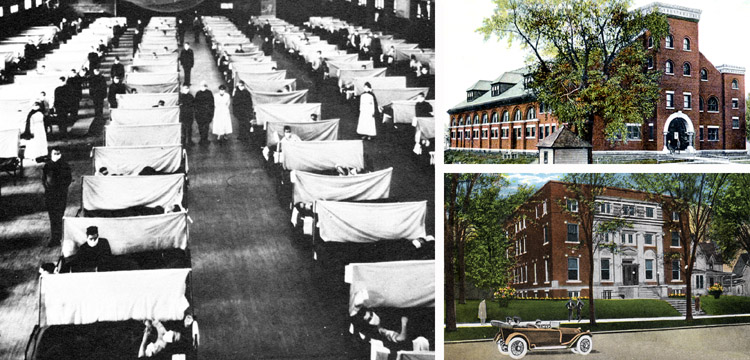|
|
|
From the non-extant University of Iowa Men’s Gym (upper right) to the Masonic Temple (lower right) downtown, infirmaries housed dozens after local hospitals filled with 1918 flu epidemic victims. Deaths during mid-October halted nearly all local activity; streets mirrored a ghost town.
By
Bob Hibbs As
flu season approaches, a 1918 flu epidemic – which claimed 38 lives in
Iowa City and resulted in marshal law on the University of Iowa campus
– recalls an image of deserted downtown Iowa City streets. That
outbreak of “Spanish Influenza,” which almost certainly did not
begin in Spain, began during summer 1918 and spread worldwide during the
ensuring winter. It showed up in Iowa City during early October, peaked
during mid-October, abated by mid-November and had run its course by
yearend. Most
schools were closed from October until after Christmas. Many church
services and Sunday schools were suspended. Pool rooms, theaters,
skating rinks, dance halls and other public gathering spots were ordered
closed. A mid-October UI football game was played without spectators. The
university was quarantined; guards kept all out except those with
passes, mostly women helping at infirmaries. With
hospitals full, infirmaries for flu cases were established on campus and
at such private facilities as the Elks clubhouse (now Commerce Center)
and Masonic Temple downtown. Largest were UI Men’s Gym then along
Washington Street on a site opposite today’s University Library, and
the Women’s Gym. Highest
infection rates were among military students, members of UI’s Student
Army Training Crops who lived and worked in close quarters, part of the
World War I effort. The
disease was not understood; bed-rest was the recommended treatment. In
Sioux City where liquor already was prohibited just prior to the start
of national prohibition in 1920, police issued “medicinal” whiskey
to anyone with a physician’s order, limited to one quart! Despite
warnings, quackery flourished. Treatments included turpentine, lemon
juice, kerosene, onions, mustard poultices and numerous other items, to
be either eaten or placed on the body. People were scared, and would try
most anything on the chance it might help. The
Mayo Clinic at Rochester, Minn., experimented with a vaccine at Cedar
Rapids, but supply was far short of those willing to try it. Successful
vaccines were decades away and even today are far from uniform in
result. A
journal left by Adeline Jones recorded a death among her acquaintances
in Iowa City almost every day during the middle of October. For Oct. 13,
she wrote: “The quietest day we have had for years. Everything closed
and so few people on the streets and very few autos. Never have we had a
time like this.” Deaths
totaled 31 men, many of UI student age, and seven women who had helped
at the infirmaries. Among local residents who died are Mrs. Raymond
Slavata, Fred White, Allen Berry and Nelson West. In
a 1983 Press-Citizen article, the late Irving Weber wrote that retired
(now deceased) Iowa supreme court justice Robert Larson, a UI law grad
and Iowa City lawyer, recalled a UI classmate who seemed fine one
evening, became ill during the night and died of flu the next day. In
addition to 38 deaths in Iowa City, the 1918 epidemic claimed 6,500
lives in Iowa, a half million nationally and some 20 million worldwide,
twice the number who died in all of World War I, on the heels of which
the 1918 flu epidemic grew. Although
modern medicine now helps control such epidemics, current levels of
domestic and international travel assures modern outbreaks will be
rapidly spread worldwide; the small world effect. A
mammoth current problem is public apathy toward the dangers of
communicable diseases of all sorts. Flu shots are recommended for small
children, adults past age 50 and anyone with lung disease or compromised
immune system. Anyone seeking a flu shot should first consult a
physician. Such
action may be critically important to your future. Next
Saturday:
Train to Kinnick – 1950s style. Bob Hibbs collects local postcards and other historic ephemera and researches history related to them. |
